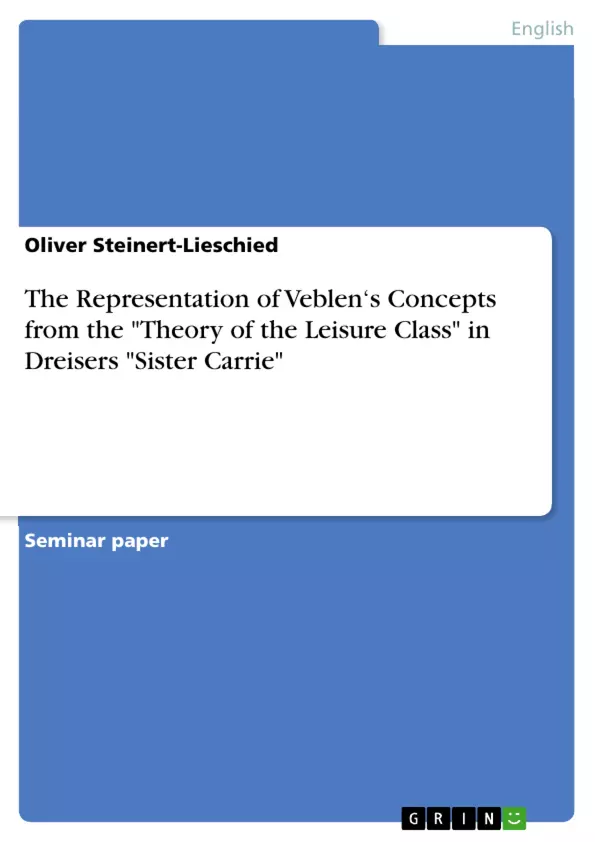With his "Theory of the Leisure Class" (1899), which is nowadays considered one of his most popular works, Veblen made himself a social outsider because his criticism of society was harsh and provoking. Although he accepted utilitarianism and praised the industrial efficiency of the engineering professions, he rejected what Mills calls the American value of the "heraldry of the greenback" and the "pecuniary fanatism of the business chieftain". Still his work was widely read and many of the problems which he saw in contemporary American society are even nowadays still quite relevant.
Dreiser's first successful novel "Sister Carrie" was written in 1900, only one year after Veblen's main work had been published. This fact, as well as the widespread interest in Veblen's theories throughout America may have influenced Dreiser at least indirectly. More important though, is whether there is some textual evidence to prove their agreements and disagreements concerning their critique of society.
In contrast to Veblen, Dreiser did not have a solid educational background and was in fact "almost a generation behind the sweep of American intellectual life" (Noble, "Dreiser and Veblen and the Literature of Cultural Change"), so many of his explanations of human hehaviour were made in terms of "chemisms" (Noble 149). Dreiser at times tended to believe Spencer's theories of social-Darwinism and that man was not much more than a „machine“ and mainly controlled by physical laws, while Veblen had rather moved beyond such notions (Noble 149). On a deeper level though, Noble considers the supposedly post-Spencerian Veblen to have unconsciously clinged to Spencer's belief in optimistic progressivism, while Dreiser had in fact transcended such notions and raised some doubts about the belief in inevitable and controlled progress in his works (Noble 148). Noble states that the "America described by Dreiser in Sister Carrie is an entirely different world from that of Thorstein Veblen." (Noble 150). In contrast to this position, Eby states that many of the behaviours and motivations of the protagonists in "Sister Carrie" are in accordance to Veblen’s concepts. She even calls Hurstwood’s fall the „Tragedy of Noninvidiousness“ (Eby 128).
In how far the characters in Dreiser's "Sister Carrie" actually behave accordingly to Veblen's concepts or not, is the topic of this work. Through my findings I will form a conclusion, in how far Veblen's and Dreiser's views of America are congruent.
Inhaltsverzeichnis (Table of Contents)
- INTRODUCTION
- VEBLEN'S THE THEORY OF THE LEISURE CLASS
- THE LEISURE CLASS
- CONSPICIOUS LEISURE AND CONSPICIOUS CONSUMPTION
- SECONDARY LEISURE CLASS
- MAIN ANALYSIS
- CARRIE MEEBER
- Carrie's Obsession for Clothes
- Carrie's Attitude Towards Work
- Theater and Theatricality
- CHARLES DROUET
- G. W. HURSTWOOD
- BOB AMES
- SUMMARY
Zielsetzung und Themenschwerpunkte (Objectives and Key Themes)
The goal of this work is to analyze the representation of Thorstein Veblen’s concepts from his Theory of the Leisure Class in Theodore Dreiser's novel Sister Carrie. By examining the characters' behavior, ideals, and thoughts, the study aims to determine the extent to which Veblen's ideas resonate with the novel's portrayal of American society.
- The distinction between the leisure class and the working class
- Conspicuous leisure and conspicuous consumption as markers of social status
- The role of work and its perceived social value
- The impact of societal pressures and aspirations on individual behavior
- The intersection of social class, wealth, and ambition in shaping individual destinies
Zusammenfassung der Kapitel (Chapter Summaries)
The first chapter provides an introduction to the work, outlining the objectives of the analysis and the context surrounding Veblen's theories and Dreiser's novel. Chapter 2 focuses on Veblen's Theory of the Leisure Class, introducing key concepts such as the distinction between the leisure class and the working class, and exploring the concept of conspicuous consumption. Chapter 3 delves into the specific examples of Carrie Meeber, Charles Drouet, G. W. Hurstwood, and Bob Ames, examining how their actions and motivations align with or deviate from Veblen's theories. The final chapter summarizes the findings and draws conclusions about the extent to which Veblen's and Dreiser's views of American society converge or diverge.
Schlüsselwörter (Keywords)
This work focuses on the intersection of social class, wealth, and ambition, exploring the representation of key concepts from Veblen's Theory of the Leisure Class in Dreiser's Sister Carrie. Key terms include conspicuous leisure, conspicuous consumption, social status, work ethic, invidious comparison, and the dynamics of class and social mobility in early 20th-century America.
- Quote paper
- M. A. Oliver Steinert-Lieschied (Author), 2006, The Representation of Veblen‘s Concepts from the "Theory of the Leisure Class" in Dreisers "Sister Carrie", Munich, GRIN Verlag, https://www.grin.com/document/145306



